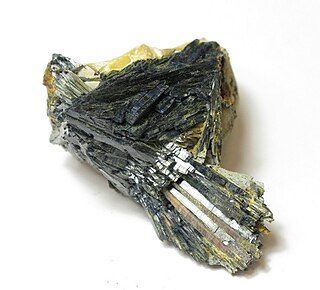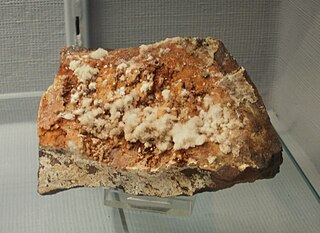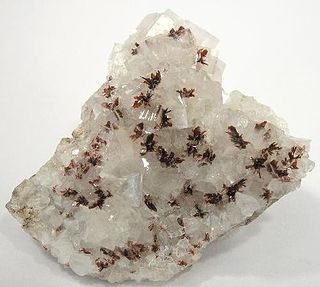 W
WAfwillite is a calcium hydroxide nesosilicate mineral with formula Ca3(SiO3OH)2·2H2O. It occurs as glassy, colorless to white prismatic monoclinic crystals. Its Mohs scale hardness is between 3 and 4. It occurs as an alteration mineral in contact metamorphism of limestone. It occurs in association with apophyllite, natrolite, thaumasite, merwinite, spurrite, gehlenite, ettringite, portlandite, hillebrandite, foshagite, brucite and calcite.
 W
WAlterite is a yellow-green mineral with the chemical formula Zn2Fe3+4(SO4)4(C2O4)2(OH)4·17H2O. Its type locality is Coconino County, Arizona. It is found exclusively in logs that have mineralized.
 W
WArhbarite is a copper magnesium arsenate mineral with the chemical formula Cu2Mg(AsO4)(OH)3. It is named after its type locality, the Arhbar mine in Ouarzazate Province in Drâa-Tafilalet, Morocco.
 W
WAstrocyanite-(Ce) is a bright blue mineral with the chemical formula Cu2(Ce,Nd,La)2(UO2)(CO3)5(OH)2·1.5H2O. Its type locality is Kamoto East Open Cut, Kamoto, Kolwezi, Lualaba, Congo
 W
WAurorite is a dark-colored mineral with the chemical formula (Mn2+,Ag,Ca)Mn4+3O7·3H2O. It is named for its type locality, the North Aurora mine in White Pine County, Nevada.
 W
WChalcanthite, whose name derives from the Greek, chalkos and anthos, meaning copper flower, is a richly colored blue/green water-soluble sulfate mineral CuSO4·5H2O. It is commonly found in the late-stage oxidation zones of copper deposits. Due to its ready solubility, chalcanthite is more common in arid regions.
 W
WChloral hydrate is a geminal diol with the formula C2H3Cl3O2. It is a colorless solid. It has limited use as a sedative and hypnotic pharmaceutical drug. It is also a useful laboratory chemical reagent and precursor. It is derived from chloral (trichloroacetaldehyde) by the addition of one equivalent of water.
 W
WCollinsite is a mineral with chemical formula Ca2(Mg,Fe2+)(PO4)2•2H2O. It was discovered in British Columbia, Canada, and formally described in 1927. It was named in honor of William Henry Collins (1878–1937), director of the Geological Survey of Canada. There are three varieties of the mineral: magnesian collinsite, zincian collinsite, and strontian collinsite. The crystal structure consists of polyhedral chains linked by weak hydrogen bonds.
 W
WEttringite is a hydrous calcium aluminium sulfate mineral with formula: Ca6Al2(SO4)3(OH)12·26H2O. It is a colorless to yellow mineral crystallizing in the trigonal system. The prismatic crystals are typically colorless, turning white on partial dehydration. It is part of the ettringite-group which includes other sulfates such as thaumasite and bentorite.
 W
WGyrolite, NaCa16(Si23Al)O60(OH)8·14H2O, is a rare silicate mineral (basic sodium calcium silicate hydrate: N-C-S-H, in cement chemist notation) belonging to the class of phyllosilicates. Gyrolite is also often associated with zeolites. It is most commonly found as spherical or radial formations in hydrothermally altered basalt and basaltic tuffs. These formations can be glassy, dull or fibrous in appearance.
 W
WHuemulite is a mineral with formula Na4Mg(V10O28)·24H2O that is yellow to orange in color. It was first discovered in Argentina in 1959 and described in 1966. The mineral is named for the Huemul mine in which it was discovered.
 W
WJennite is a calcium silicate hydrate mineral of general chemical formula: Ca9Si6O18(OH)6·8H2O.
 W
WJunitoite is a mineral with formula CaZn2Si2O7·H2O. It was discovered at the Christmas mine in Christmas, Arizona, and described in 1976. The mineral is named for mineral chemist Jun Ito (1926–1978).
 W
WMesselite is a mineral with formula Ca2(Fe2+,Mn2+)(PO4)2·2H2O. It was discovered in Germany and described in 1890. The mineral was subsequently discredited in 1940, reinstated and named neomesselite in 1955, and the name restored to messelite in 1959.
 W
WMetavivianite is a hydrated iron phosphate mineral found in a number of geological environments. As a secondary mineral it is typically formed from oxidizing and dehydrated vivianite. Metavivianite is typically found as dark blue or dark green prismatic to flattened crystals.
 W
WOkenite (CaSi2O5·2H2O) is a silicate mineral that is usually associated with zeolites. It most commonly is found as small white "cotton ball" formations within basalt geodes. These formations are clusters of straight, radiating, fibrous crystals that are both bendable and fragile. It also belongs to the family of the calcium silicate hydrates (C-S-H) commonly found in hardened cement paste. In cement chemist notation (CCN) it is noted as CaO·2SiO2·2H2O and abbreviated as CS2H2.
 W
WOpal is a hydrated amorphous form of silica (SiO2·nH2O); its water content may range from 3 to 21% by weight, but is usually between 6 and 10%. Because of its amorphous character, it is classed as a mineraloid, unlike crystalline forms of silica, which are classed as minerals. It is deposited at a relatively low temperature and may occur in the fissures of almost any kind of rock, being most commonly found with limonite, sandstone, rhyolite, marl, and basalt.
 W
WPascoite is a mineral with formula Ca3V10O28·17H2O that is red-orange to yellow in color. It was discovered in the Pasco Province of Peru, for which it is named, and described in 1914.
 W
WGypsum Plaster/Powder is a building material used for the protective or decorative coating of walls and ceilings and for moulding and casting decorative elements. In English "plaster"/Powder usually means a material used for the interiors of buildings, while "render" commonly refers to external applications. Another imprecise term used for the material is stucco, which is also often used for plasterwork that is worked in some way to produce relief decoration, rather than flat surfaces.
 W
WRapidcreekite is a rare mineral with formula Ca2(SO4)(CO3)·4H2O. The mineral is white to colorless and occurs as groupings of acicular (needle-shaped) crystals. It was discovered in 1983 in northern Yukon, Canada, and described in 1986. Rapidcreekite is structurally and compositionally similar to gypsum.
 W
WRuizite is a sorosilicate mineral with formula Ca2Mn2Si4O11(OH)4·2H2O. It was discovered at the Christmas mine in Christmas, Arizona, and described in 1977. The mineral is named for discoverer Joe Ana Ruiz.
 W
WThaumasite is a calcium silicate mineral, containing Si atoms in unusual octahedral configuration, with chemical formula Ca3Si(OH)6(CO3)(SO4)·12H2O, also sometimes more simply written as CaSiO3·CaCO3·CaSO4·15H2O.
 W
WTobermorite is a calcium silicate hydrate mineral with chemical formula: Ca5Si6O16(OH)2·4H2O or Ca5Si6(O,OH)18·5H2O.
 W
WIn chemistry, water(s) of crystallization or water(s) of hydration are water molecules that are present inside [crystal]s. Water is often incorporated in the formation of crystals from aqueous solutions. In some contexts, water of crystallization is the total mass of water in a substance at a given temperature and is mostly present in a definite (stoichiometric) ratio. Classically, "water of crystallization" refers to water that is found in the crystalline framework of a metal complex or a salt, which is not directly bonded to the metal cation.